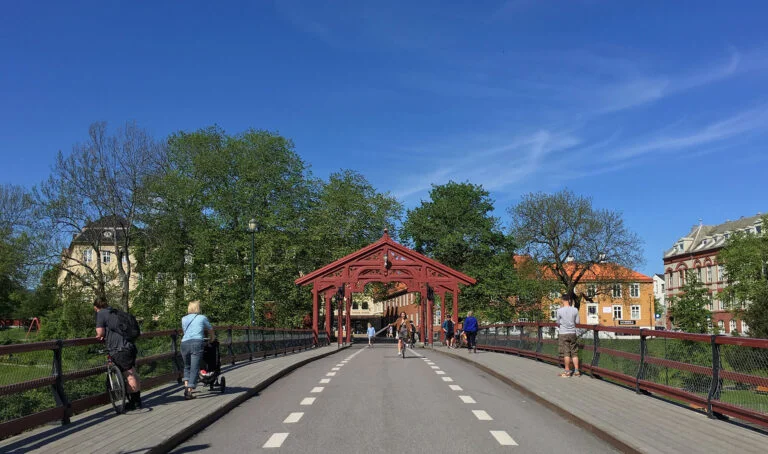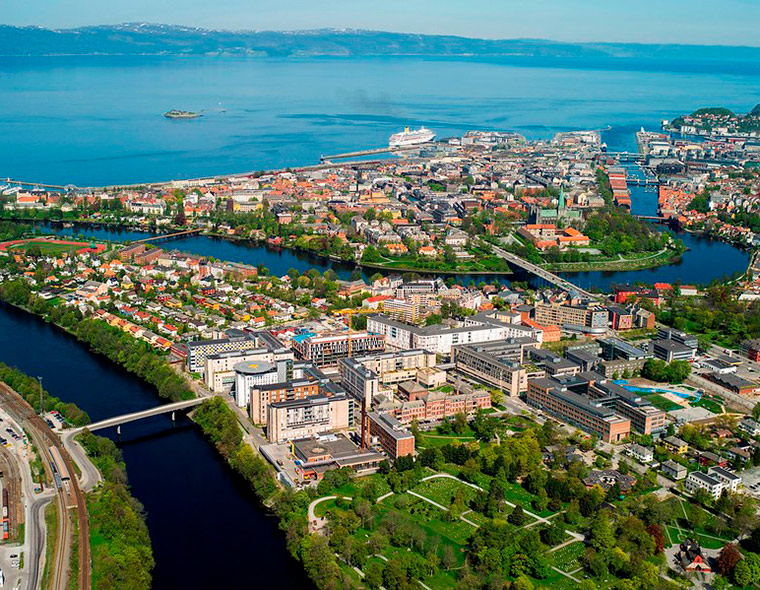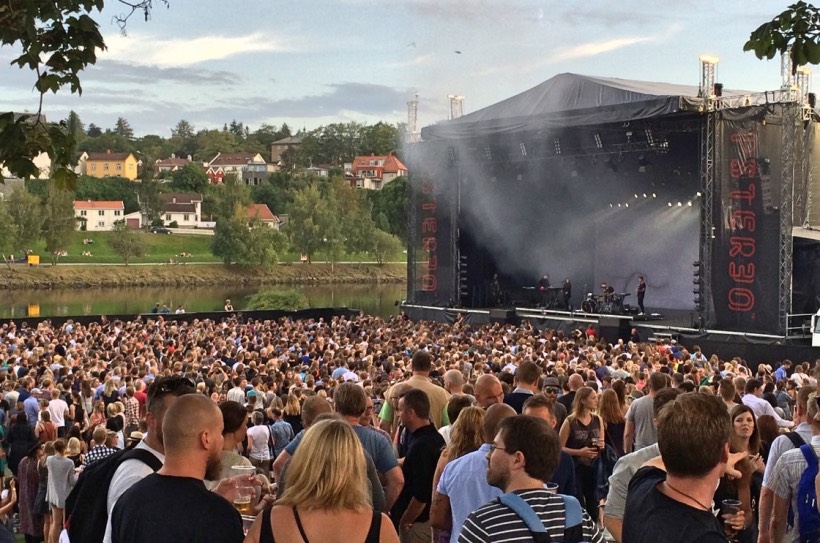An introduction to Trøndersk, the dialect of the Norwegian language spoken in Trondheim and much of central Norway.
Picture the scenario: you spent countless hours learning Norwegian in Oslo. You are quite proud to be able to understand news broadcasts (mostly) and chat to your barista while waiting for your morning coffee.

Then you sit on a northbound train for a few hours and when you get off, every other encounter with a stranger shatters your already shaky confidence in learning Norwegian.
What people are saying vaguely sounds like words, but often it seems like it’s a succession of vowels being sung to some abstract tune.
Welcome to your first contact with Trøndersk: the dialect(s) of Trondheim and the surrounding areas. It may seem daunting at first – that’s because it is, largely – but hopefully our little guide will help deconfuse stuff a little bit.
What is a dialect?
A dialect is a regional variety of a language that distinguishes itself by features such as vocabulary, pronunciation and grammar. The line between dialect and language is fuzzy.
Fully-blown languages often start as a regional dialect that gets elevated for geographical and practical reasons.
French is an example of this. In the 17th and 18th century, the Parisian version of French became the “official” one, with other variations deemed inferior and shameful.

In Norway, regional dialects are anything but shameful. On the contrary, they are often a source of pride, and it is common for people to hold on to their local dialect years after having left the area where it is commonly spoken.
What does Trøndersk sound like?
Trøndersk sounds quite different from the Norwegian spoken in Oslo. So different in fact, that an acute listener that knows nothing of Norwegian can hear the difference.
The difference for this is threefold: tonality, vowels, and something called palatalisation.
Tonality in Norwegian and Trøndersk
To a native English speaker, Norwegian as a whole sounds oddly melodic. Norwegian speakers adopt tonal patterns that sound unusual when you have never heard them before.
People who speak Trøndersk adopt even more peculiar tonal patterns. Since it’s so difficult to describe, here’s a video.
There is applause and laughter because this clip was used in a humour show as an example of a dialect that is difficult to understand. But it is a very good example of the strange singing that is used in Norwegian – and even more so in Trøndersk.
Note that Norwegian is not a tonal language (like Mandarin or Vietnamese) but falls in the similar-but-different category of pitch-accent languages.
Vowels in Trøndersk
Disclaimer: I am about to oversimplify quite a bit. But people speaking Trøndersk sound like they use vowels more.
To a person not familiar with the language and listening to people speaking it, “standard” Norwegian has a good balance between consonants and vowels. It “flows”, a bit like Japanese.
Trøndersk, though, sometimes sounds like a succession of vowels. There are several reasons for this.
The first one is that many words used in Trøndersk have fewer consonants than their Østlandsk (Oslo) equivalents. The pronoun “hun”, for example (she), becomes “hu”. The pronoun “henne” (her) becomes simply “a”. In both cases, consonants disappear.
The second reason is called apocope. This is a linguistics term that means that the last vowel or syllable of a word is left unpronounced.

Paradoxically, dropping the last vowel of a word sometimes makes the whole word sound more “vowelly”. Take the verb “å kjøpe” for example (uh shuh-puh). In Trøndersk, people will more often than not say “å kjøp” (uh shuuhp).
Because the last vowel is skipped, more length/importance is given to the only one that’s left.
Palatalisation: how to make your consonants ‘moist'
Palatalisation is a linguistic term that means pushing your tongue against your palate when pronouncing a consonant. When you say “n”, for example, the tip of your tongue typically touches an area of your palate just above your teeth.
With palatalisation, you press a larger portion of the tongue against the palate. It has the effect of making you sound funny.
Because of this, in Trøndersk, “han” (he) becomes “hañ” (often spelt hanj). The sound is similar to the ñ in jalapeño – assuming the word is pronounced in the proper Spanish way.
Trøndersk vocabulary
In addition to pronunciation and tonality quirks, Trøndersk has its own vocabulary that makes it sound different. This is particularly problematic for foreign speakers, because it means that they will have no knowledge of many of the words commonly used.
You see, more often than not, when a dialect uses a completely different word, it’s one that’s used very commonly, such as “I”, “girl”, “how” or “tired”. This applies not only to Trøndersk but to all Norwegian dialects.
The upside of this is that if you learn the 100 most common words in a given dialect, you’ll have come a long way in reducing the noise and increasing your understanding.

The more complicated words, like “philosophy”, “contemporary art” or “metaphysics” are likely to be exactly the same regardless of the dialect.
Examples of Trøndersk vocabulary
Here are examples of these common words that become totally different in Trøndersk.
| Trøndersk | Bokmål | English |
| æ | jeg | I |
| veitj | jente | girl |
| koss/kossen | hvordan | how |
| klar | sliten/trøtt | tired |
| mytji | mye | much/a lot |
The pronoun for “I” is one that can help you pinpoint which dialect people are speaking. In Trøndersk it is usually “æ”. Describing with words how to pronounce vowel sounds is notoriously difficult, but “æ” has been described as similar to the sound made by the letter “a” in “sad”.
“Veitj” is another word you may come across that can be very confusing because it’s so different from the bokmål word it replaces. Not all people who view themselves as speaking Trøndersk use it though; some use “jente”, but with the “n” palatalised as described above.
“How” is another word that varies a lot from one dialect to the other. In Trøndersk, it becomes “koss” or “kossen”, more often than not.
“Klar”, confusingly, exists in bokmål as well but means something completely different: “ready”. When suppressing a jet lag induced yawn at a wedding, I was asked “Er du klar?”, to which to my Trøndersk-ignorant self answered “Klar til hva?” (Ready for what?).
Mytji, for which I won’t even attempt to describe the pronunciation, means “much” or “a lot”, and is one of those examples where the boundary between unusual pronunciation and different vocabulary becomes fuzzy.
There is more than one Trøndersk
Before my inbox gets inundated, let me make something clear: the list above is not written in stone. Not all people who view themselves as speaking Trøndersk use the words above.
Some use even more obscure ones, others use the bokmål equivalents. Language is fluid and ever-evolving, and the dialect a person speaks really depends on their background: such as where they are from specifically, where they live currently and how old they are.
How to understand Trøndersk
So now that you know a bit more about Trøndersk, here are some tips to understand it better.
Keep an open mind
Some of the words that are different from one dialect to another are quite different – like those we listed above – but others are just pronounced a little differently. If you open up your mind to accept pronunciation differences, you’ll get a lot for free.

The bokmål word for floor, “gulv”, often becomes “gølv” in Trøndersk. Some words with “i” suddenly take an “e” in Trøndersk. Seeing vowels as largely interchangeable will help you figure out the meaning of words that, when first hearing them, seem completely unknown.
Learn the most common words
There are about a dozen ways to say “how” in Norwegian dialects, and the solution to that as a non-native speaker is, unfortunately, to learn them. If your focus is Trøndersk exclusively, then knowing both “hvordan” and “koss/kossen” should be sufficient.
Similarly, you’ll need to learn the other very commonly used ones. Here, the book An introduction to Norwegian dialects is invaluable.
It provides a very useful introduction to the large Norwegian dialect families, with word lists and details on their pronunciation particularities. It’s a relatively quick read as well, so I can’t recommend it enough if you are interested.
Ask questions
Learning a languages goes hand in hand with accepting that you’ll sound stupid from time to time. One part of that means making mistakes, the other means asking people about that word they just used that you didn’t understand.
No matter how good you are at finding information yourself and learning new words and pronunciation rules, you are guaranteed to come across words that you either forgot or never encountered. Luckily, Norwegians are happy to help, most of the time, and they are usually pleased to see someone showing interest in their native dialect.
Tell us what you think
Do you know someone who speaks Trøndersk? Have you been in the Trondheim or Trøndelag area before? What do you think about dialects? Let us know in the comments!


Jepp. My husband is trønder, born and bred. I was literally shocked at my very first trøndersk family gathering. Everyone spoke trøndersk soooooooo fast and altogether they sounded like machine gun… LOL!
I am now in my 8th month (in Trondheim) and till now I cannot find the courage to start to learn the language 🙁 I always think it is too hard for me to learn but I am motivated now after understanding a bit of how it is form your article. I think I will just start with the basics: bokmål. Thanks!